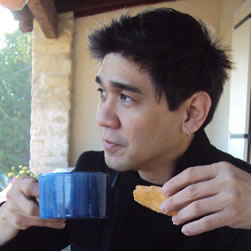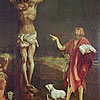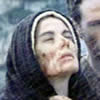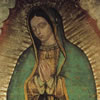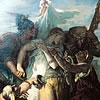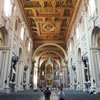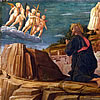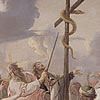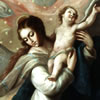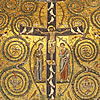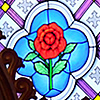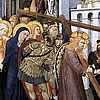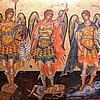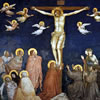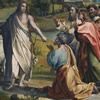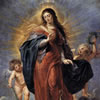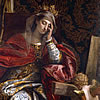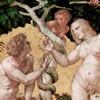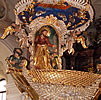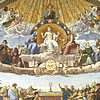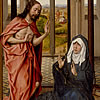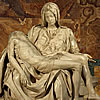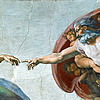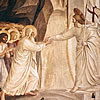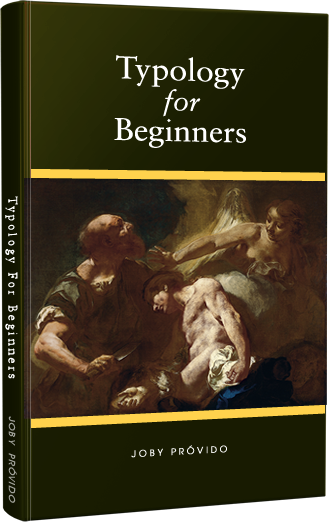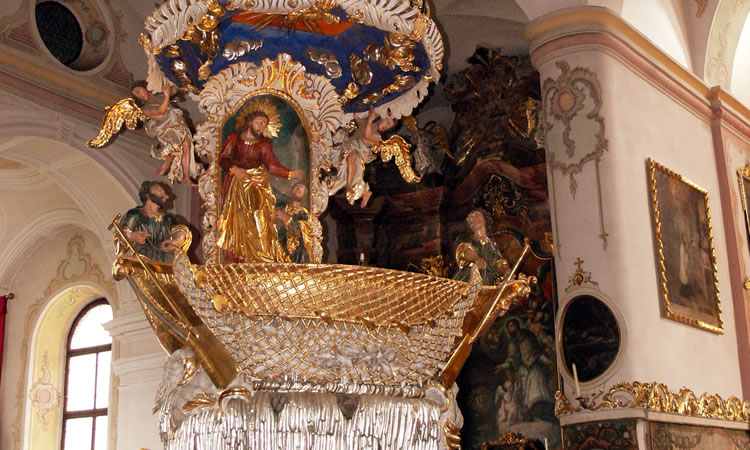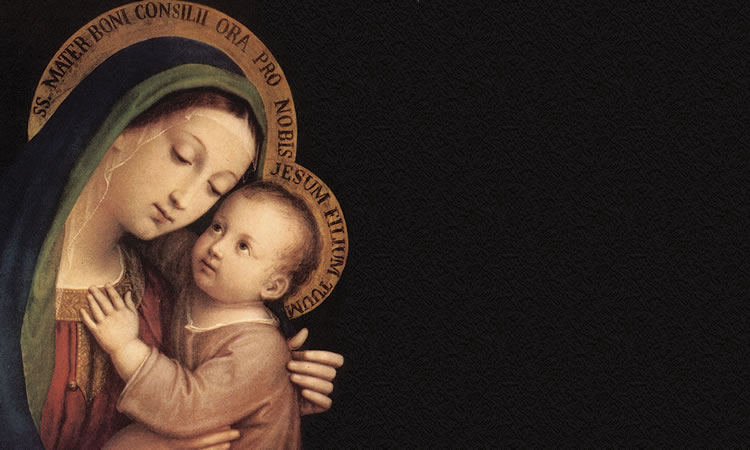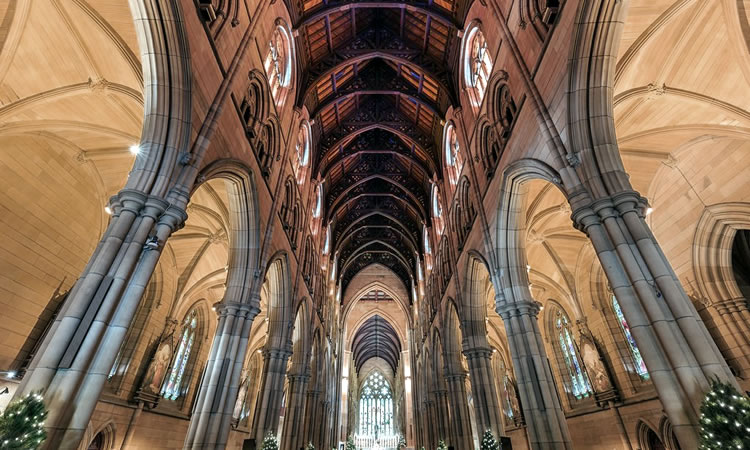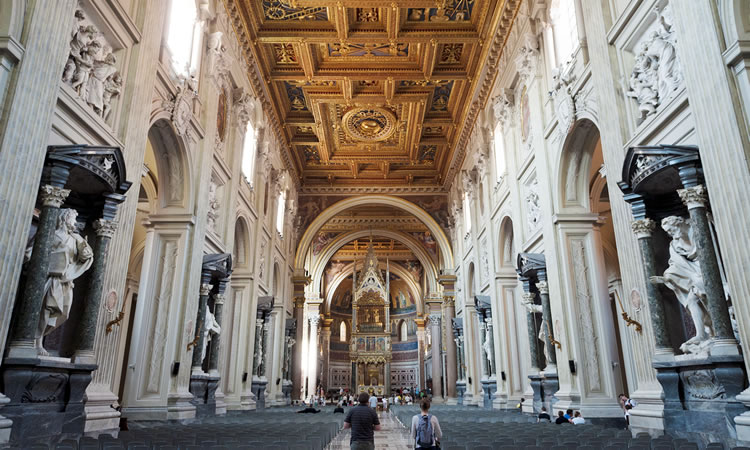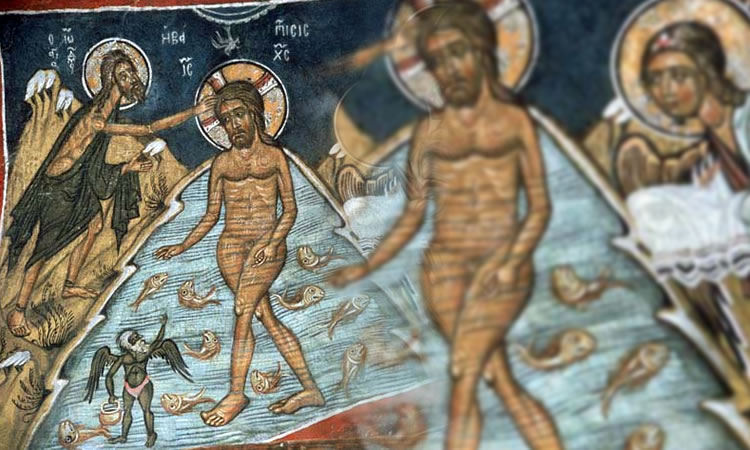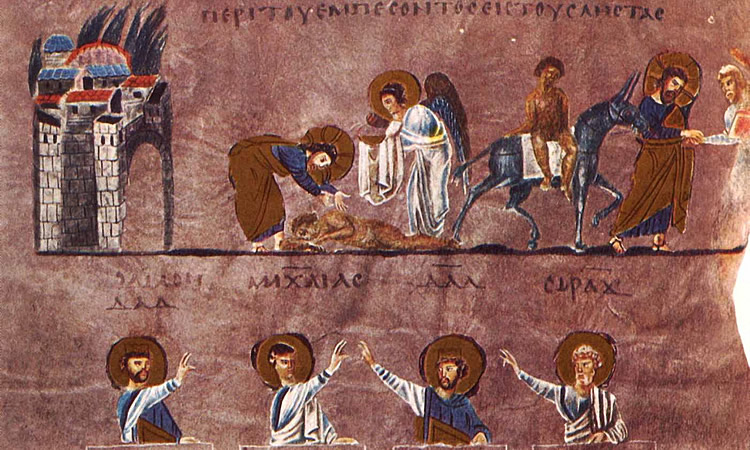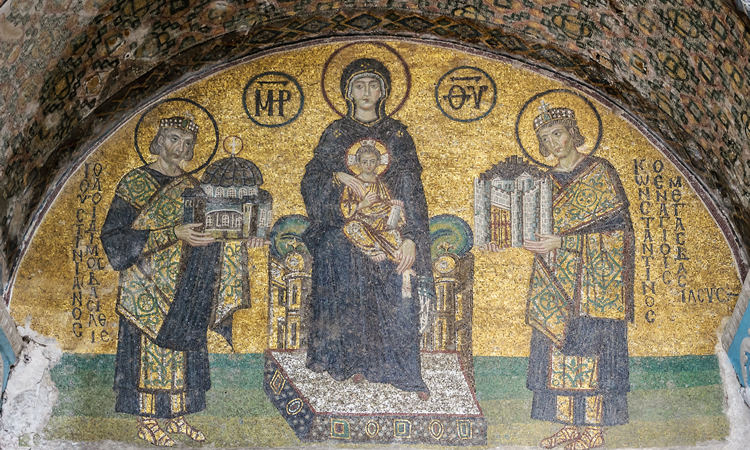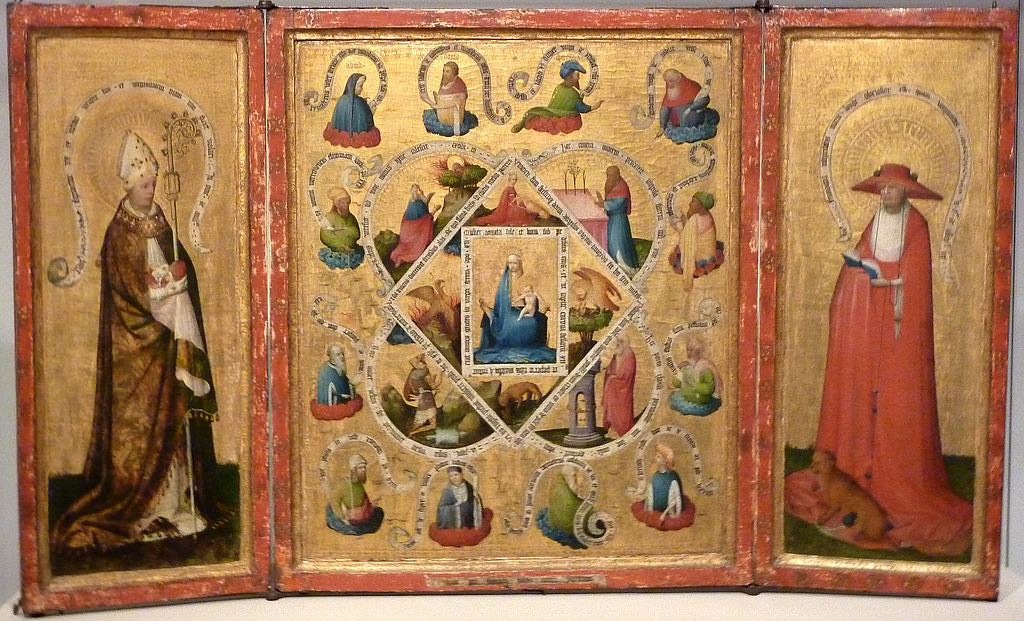

Triptych in Defense of Mary's Perpetual Virginity
Triptychs are works of art that are divided into three sections or panels. Quite often religious triptychs were used as backgrounds for Church altars. The hinged two outer panels are usually closed. They were opened during special occasions to reveal the large central panel. In this particular triptych, the opened left panel shows St. Augustine, and the opened right panel shows St. Jerome. When closed, the left panel shows St. John the Baptist, and the right panel shows St. Paul (we have no picture of this.)
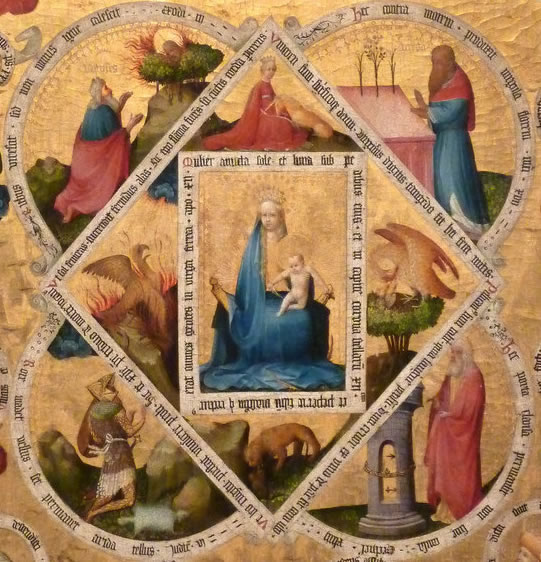
This particular triptych is interesting because it has two basic themes that use symbolism and typology. The central panel has a rectangle in the center that shows the Blessed Virgin with the baby Jesus on her lap. Around that are four triangles with images that symbolize the saving work of Christ. And attached to each triangle is a semi-circle that looks like the leaves of a four-leaf clover. In these semi-circles are typological images of Mary’s virginity.
Symbolism and typology are different. Symbolism uses an object to represent an idea attached to it. Typology, on the other hand, is people, objects, or events in the Old Testament (called types) that foreshadow something that is fulfilled in the New Testament (called anti-types). Think of the Holy Spirit as an author who drops hints in the Old Testament that hint of something to come.
Woman of Revelation
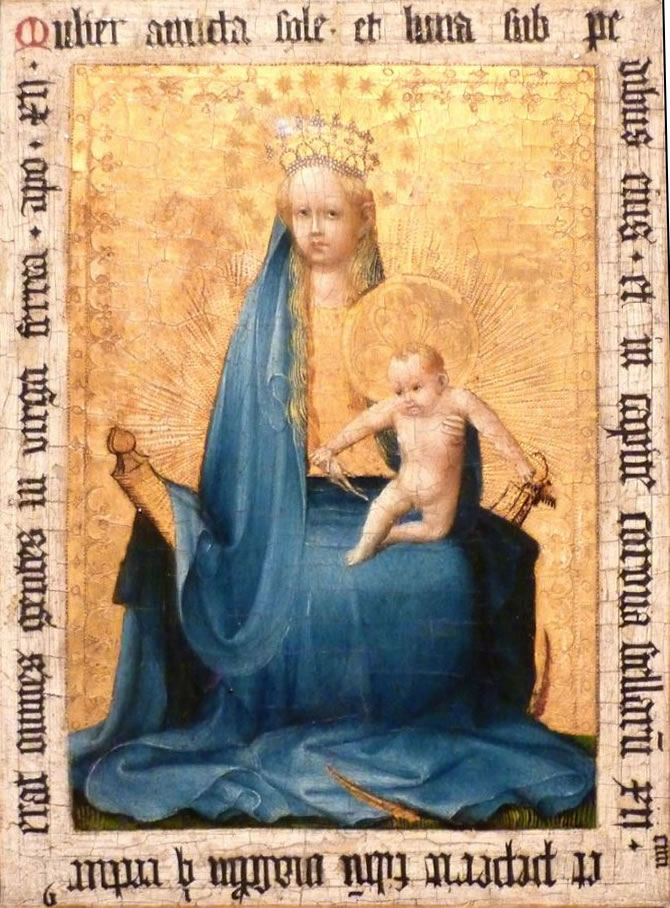
The central image depicts Mary sitting on a throne with the child Jesus on her lap. We can’t miss the similarity of how the artist paints her as the woman in the Book of Revelation: clothed with the sun, the moon under her feet, and wearing a crown of twelve stars. (Revelation 12:1)
Paschal Mystery: The Salvation Theme
Around this central image are four triangles that symbolize salvation history. It starts at the top and moves clockwise.
The Incarnation
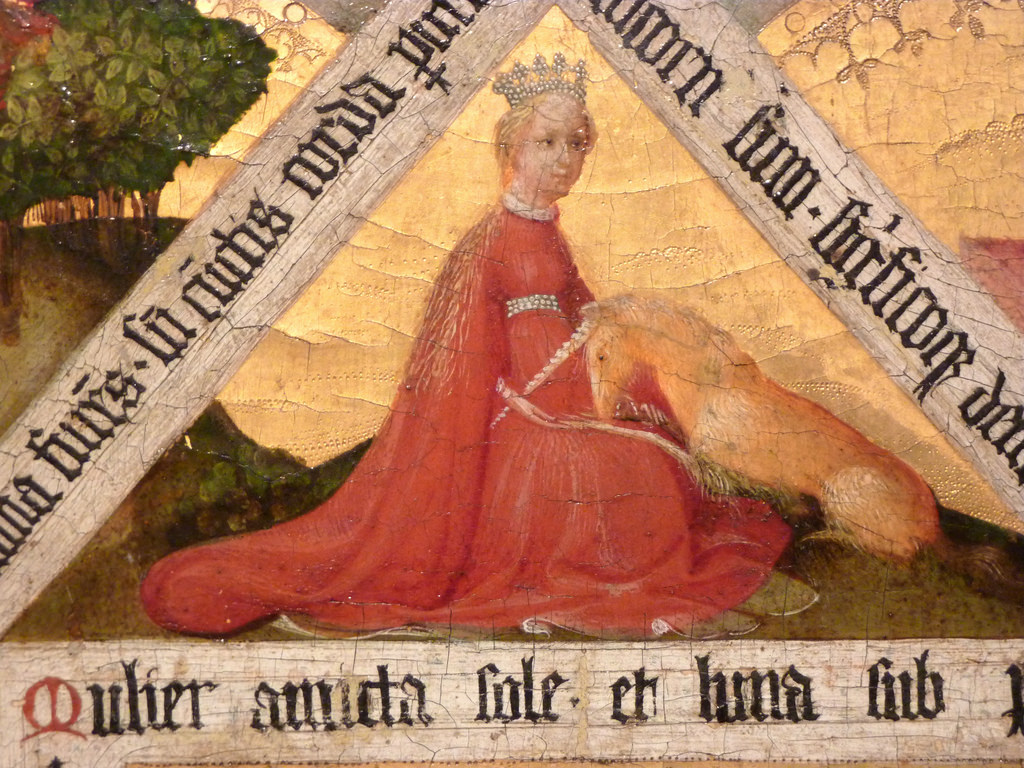
The top triangle shows a woman in red with a unicorn on her lap. In an ancient custom, there is a sacred marriage rite that unites a king and princess in a bridal chamber. The woman depicted here wears a crown that implies she is the princess. Her red gown implies she is a bride for red was the color that brides wore to a wedding in ancient times. The unicorn symbolizes power and strength and represents the king who is the bridegroom.
Interestingly, unicorns are said to have healing powers. They could cure disease, counteract poison, and purify waters. This makes the unicorn a good symbol for Christ for he cured disease, he rendered powerless the poison of death, and he purified the water of his baptism in which we all bath to wash away original sin that pollutes our human nature.
There is also an ancient legend where only a virgin can tame a unicorn. She sits down and offers her lap, and the unicorn is drawn to it and eventually lays its head on her lap. Putting these together, Church scholars like to say that this imagery depicts Christ the King, entering the womb of the woman. It is the uniting of king and princess in the “bridal chamber” that is the womb. In a sense, Christ and Mary are being depicted here at the moment before this union in something that is better than marriage: an incarnation.
Self-Sacrifice
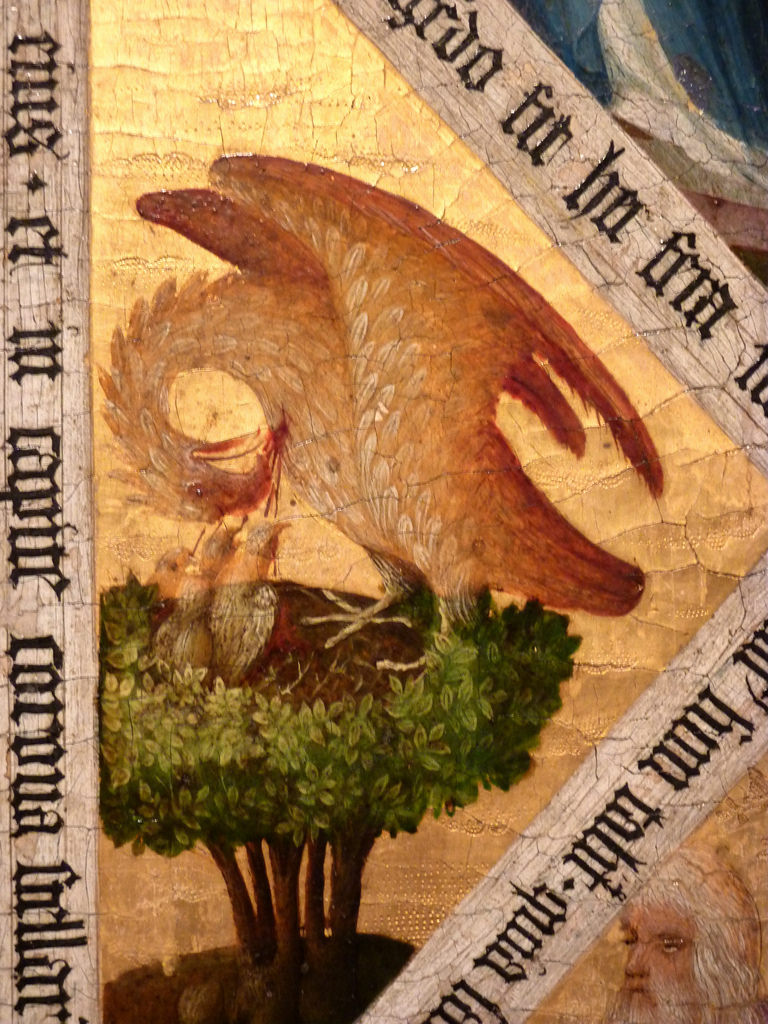
Ancient Europeans believed that pelicans would pierce open its breast with its beak so it could feed its young with its own blood. As the legend goes, it was also believed that Pelicans could bring back to life, any of its young that died, by giving them its blood.
Early Christians would not miss the wound of Christ on his side where the position of the pelican in this painting pierces its side. The Church Fathers saw that the blood from the side of Christ watered the Church. It is from his side that the Church, his bride, emerged from – the same way as Eve, the bride of Adam, came from his side.
We see in this image of the pelican the crucifixion of Christ where he empties himself of life and blood so we can all have the spiritual life that allows us to live forever.
This sentiment is preserved by St. Thomas Aquinas who was said to write in the Adoro Te Devote:
Like what tender tales tell of the Pelican
Bathe me, Jesus Lord, in what Thy Bosom ran
Blood that but one drop of has the power to win
All the world forgiveness of its world of sin.
To seal this symbolism, we shouldn’t miss how Christ feeds us his body and blood in the Eucharist as spiritual food that nurtures and keeps our soul alive.
Resurrection
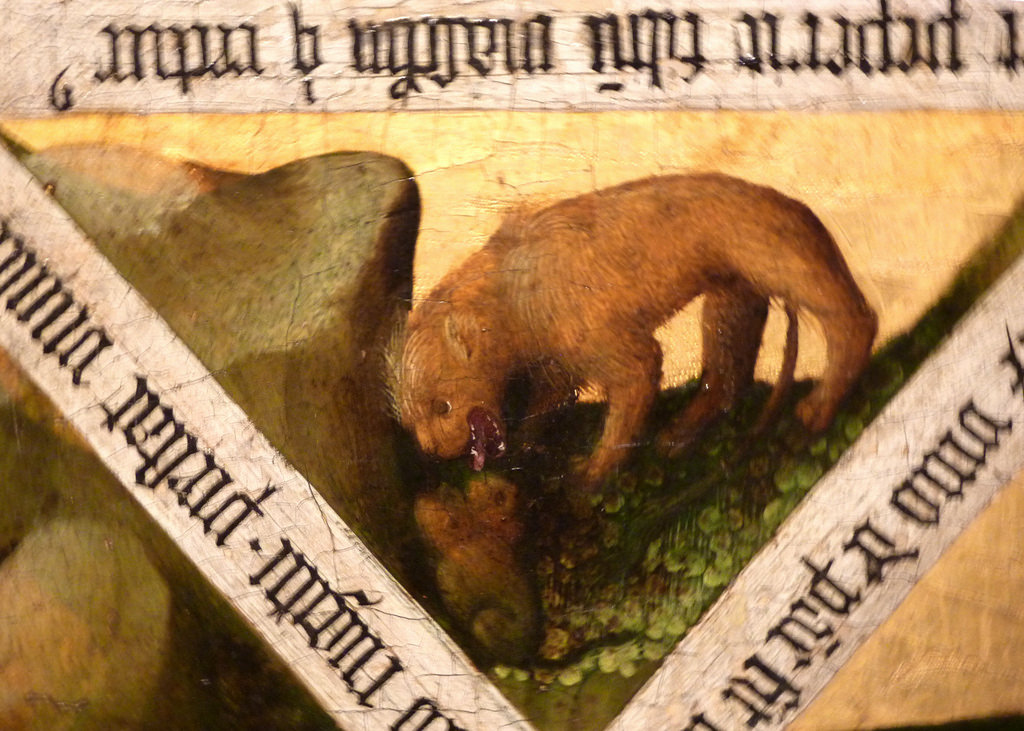
The third image in the Salvation Theme is a lioness licking her young. This symbolism is based on another ancient belief that supposed offspring of lionesses came out dead, but by licking them continuously for three days, they were given life. (Kathleen Cohen, Kathleen Rogers Cohen Metamorphosis of a Death Symbol, University of California Press, 1973)
It isn’t difficult to see that this symbolism points to Christ who died and was reborn after three days.
Ascension
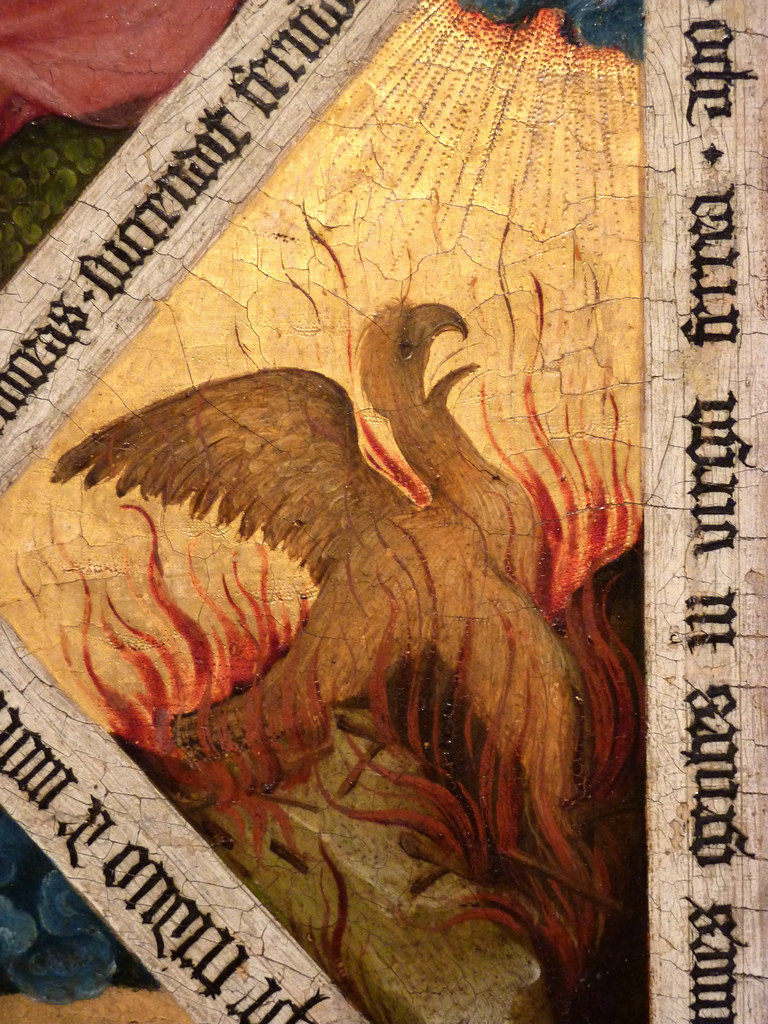
The final image of the Salvation theme shows the phoenix rising from the ashes. It was a belief that the phoenix lived for 500 years, after which it would prepare a nest of frankincense and myrrh. There it would die a fiery death and be transformed again anew to fly away in a new life.
When Christ resurrected his body was transformed. He could pass through locked doors, and he could prevent others from recognizing him. It is like the body all the faithful will get at the end of time when body and soul are brought together again.
Finally, like a phoenix that could fly, Christ ascended to heaven where the father accepts him and his sacrifice.
The Ever-Virgin Theme
In a very loose translation, one title of this particular triptych is: “In defense of the inviolate and undefiled virginity of Mother Mary.” In this theme, we will see how Old Testament events foreshadow the virginity of Mary. There is no particular starting point, but let us discuss it from the lower left and go clockwise (only because it has a nicer flow to it.)
Gideon and the Fleece
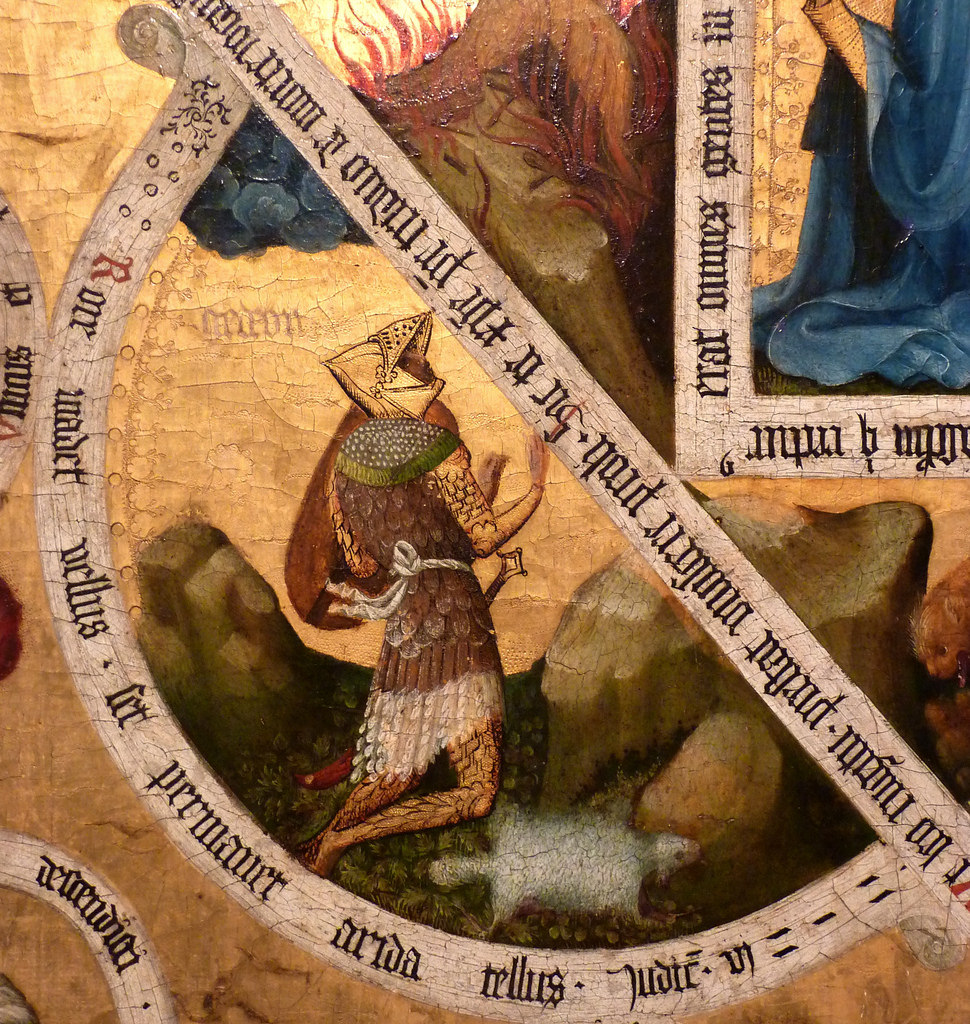
Before God anointed kings to lead Israel, he sent judges. These were not magistrates in courts of law, but leaders who would help God’s people from her enemies. Gideon was one such judge.
When Midianites plagued the Israelites, God sent a message to Gideon to lead an army to fight them. Thinking he was just hallucinating, he asked God for a sign. He asked that God would wet his fleece with heavenly dew without the ground around it getting wet. This, God granted. After leaving the fleece on the threshing floor that night, he found it so wet the next morning that he was able to wring out enough liquid to fill a bowl. (Judges 6:37-38) Gideon, then led the army to victory as God asked him to do so.
The filling of the fleece with heavenly dew is the prefiguration of Mary’s womb being filled with “heavenly dew” that is the Second Person of the Trinity. As the ground around the fleece was undisturbed, so was the virginity of Mary not violated in any way.
Interestingly the sign for Gideon that he would lead God’s people to victory was the miraculous fleece filled with dew, and the sign that we have that Mary would lead God’s people to victory, by giving birth to the Messiah, is his miraculous incarnation in her womb. It shouldn’t surprise us that the opening words of the messenger to Gideon was, “the Lord is with you”, the same words the angel (which means “messenger”) used to greet Mary.
Moses and the Burning Bush
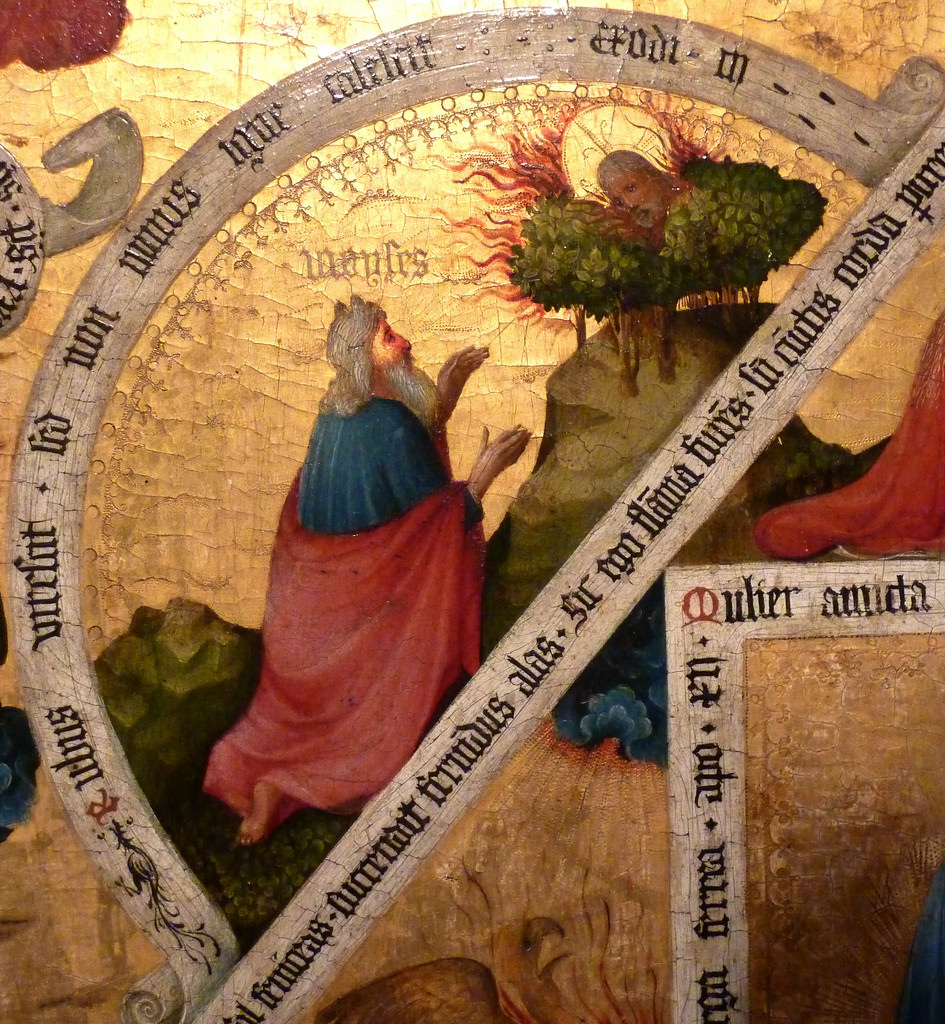
In the Book of Exodus, we read of God appearing to Moses in the form of a burning bush. We must notice the detail of how the bush is described: “although the bush was on fire, it was not being consumed.” (Exodus 3:2) To ensure this is what we are seeing in this painting, the artist draws the bush green (not dried up.)
This foreshadows how the incarnation does not defile the virginity of Mary. If God can inhabit a bush without consuming it, he can inhabit a woman’s womb without “consuming” her virginity.
Aaron and the Flowering Staff
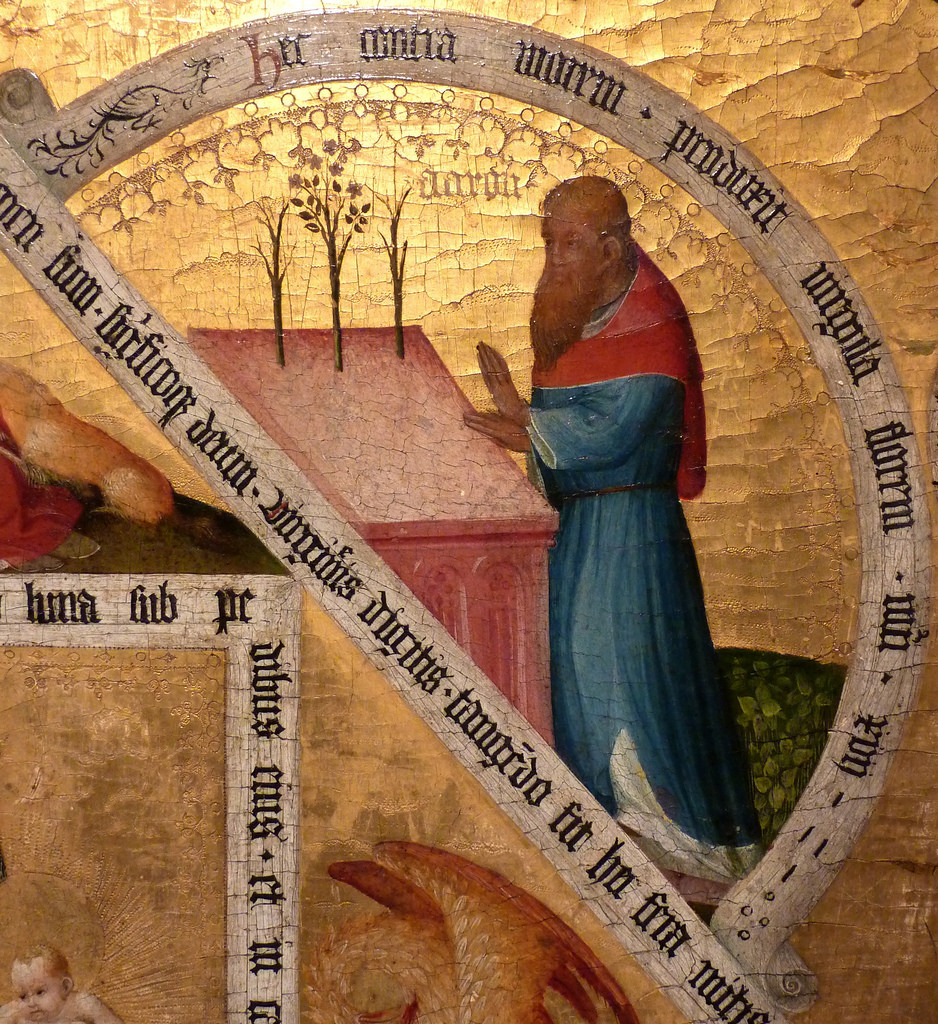
On the way to the Promised Land, the Israelites grumbled against Moses for taking them to the desert where they were hungry. Levites under a man named Korah openly rebelled even if their tribe was the chosen one to be priests of God’s covenant. God consumed Korah with fire and allowed the earth to open up and swallow those who rebelled with Korah.
Despite this display, the Israelites continued to complain against Moses. So God commanded that a staff (a wooden rod sometimes used for shepherding) from each of the twelve tribes be brought into the Tent of Meeting. The next day the staff of Aaron, who was from the tribe of Levi, sprouted. It produced blossoms and ripe almonds. (Number 17:16-23)
God then made Aaron, and his ancestors, “responsible for any sin with respect to the sanctuary… and with respect to the priesthood.” This priesthood would represent humanity when they slaughtered animal victims when making atonement.
It is indeed a miracle that dead wood, that has no business bringing forth any life, would sprout and produce fruit. It is a prefiguring of Mary, who had no means of bringing forth any life for she had no human agent to get her pregnant. Yet she conceived Jesus and gave birth to him.
What is more interesting is that many years later after Aaron was made high priest, the prophet Isaiah foretold that, “a shoot shall sprout from the stump of Jesse…” He was speaking of Jesus, the Messiah. The stump he was referring to was the kingdom of King David, the son of Jesse. When Israel turned back to idolatry, it split and foreign kingdoms took advantage of this. They invaded and exiled Israelites. The Davidic Kingdom became a “stump” because no sane descendant of David would dare claim the throne lest they be put to death by the invading colonizers.
It was this way many years until Jesus claimed the Davidic throne. Firstly he was the son of Joseph who is a descendant of David. Matthew lists down this ancestry, and Luke tells us Joseph went to his hometown of Bethlehem – also known as David’s Royal City for it was David’s birthplace. Pope Benedict XVI, in his book Jesus of Nazareth, explains that when Jesus requested for a colt that was never ridden, it was a claim to kingship because only kings had the right to request for transportation that was never used before. The entry into Jerusalem also reminds us of a king’s entrance because the people were reenacting Psalm 118 where a king makes an entrance and people join the procession with leafy branches. When John shouted, “make straight the path of the Lord,” it is a reference to an ancient customer to how mountains should be flattened and valleys be filled so that a road can be as straight as possible for a visiting king to travel on.
So the staff the bloomed in the Old Testament is no longer a real staff in the New Testament, but a figurative one as the family tree of King David. Mary is the staff, and Jesus is the fruit. He is the high priest who takes all of our sins and represents all of humanity when he makes his sacrifice to the Father. It is no longer an animal sacrifice, but a human and divine sacrifice that creates a new covenant that lasts forever.
The Closed Gate
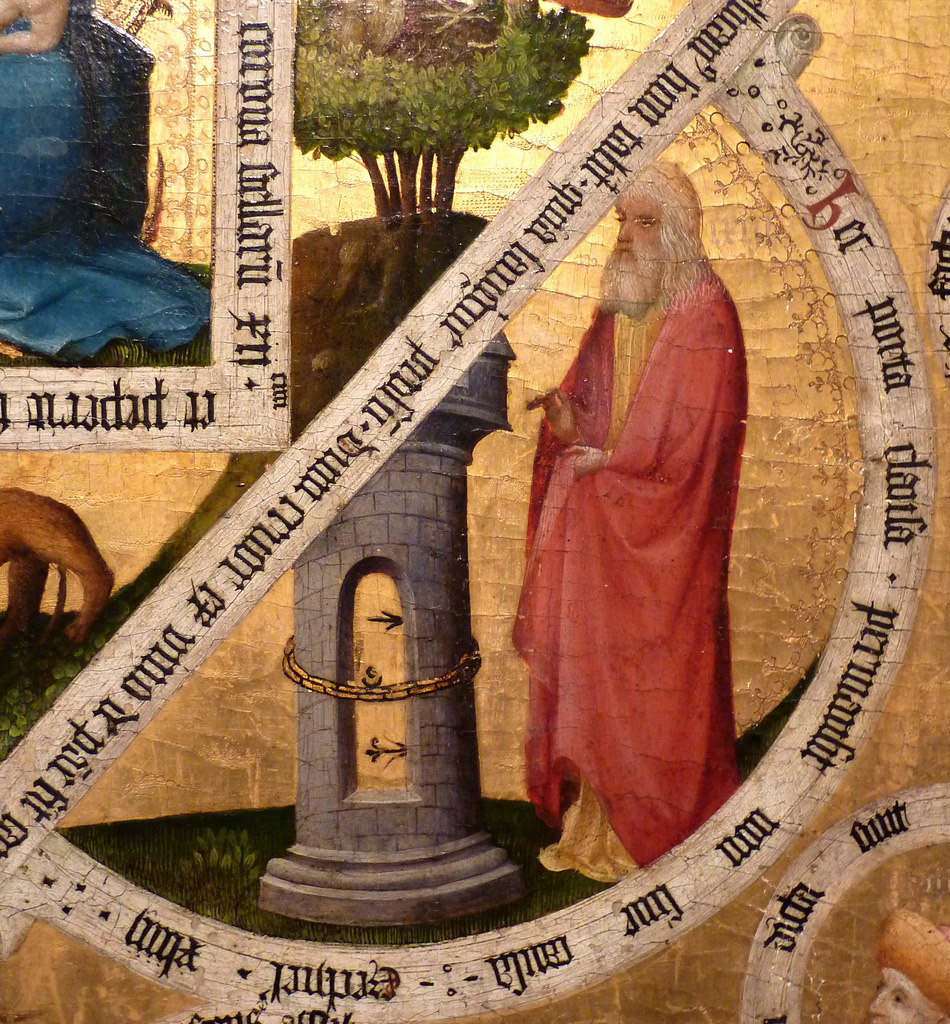
When Israel had committed abominations against God, Ezekiel prophesied that the presence of God would rise from the Temple and leave. It would come back from the East Gate of the city and when it does the gate must be shut because, “the Lord, the God of Israel came through it…” (Ezekiel 43,44)
The Gospel writers mention the eastern route taken by Christ when he entered into Jerusalem. Mark, for example, puts him in Bethpage and Bethany which is east of Jerusalem. (Mark 14:3-9) Isn’t Christ the “presence of God” and “the Lord” who entered through that gate?
Interestingly, the eastern gate was closed by the Muslims in 810 and reopened by Crusaders in 1102. But it was sealed shut by Saladin in 1187 when he recaptured Jerusalem. Scholars suggest he had the gate shut because he knew of the Jewish prophecy. To prevent any hope of the Messiah going through it (which might spark a rebellion) he had it sealed forever. If this is so, he unsuspectingly fulfilled the prophecy of Ezekiel for Christ had already passed through it.
While the eastern gate is a real thing, it foreshadows the womb of Mary. We call her The Gate of Heaven not because she is our way into heaven. (That is Christ’s sole role!) No, that is her title because she is the “gate” from which the Second Person of the Blessed Trinity passed through in becoming human. It is a gate from heaven to earth. And once Jesus passed through her womb, it was permanently shut. It would be absurd that her womb would be used for anything else mundane after it was used by God himself. The “shutting of her womb” is a way of clarifying Mary’s perpetual virginity: she was a virgin before, during, and after Christ’s birth.
In Conclusion
The placement of the particular images on the triptych is important too. We have the New Adam and New Eve in the center of the painting as a symbol of a new creation. The new creation is part of the Paschal Mystery: the incarnation, death, resurrection, and ascension of Christ. It is a mystery surrounded by another mystery: the virgin birth.
The Christian story is an exceptional one with many layers that transcend millennia. It just shows how wonderful our written and oral Traditions are if some books of the Bible are separated by thousands of years and yet make sense when read together. In this case, we must see that the perpetual virginity of Mary is not something we make up to venerate her, but instead, it was part of God’s plan as foretold millennia prior to the New Testament.
Photos are from the Flickr Album of Petrus.Agricola


